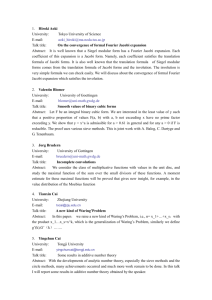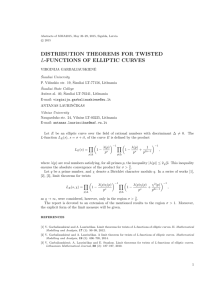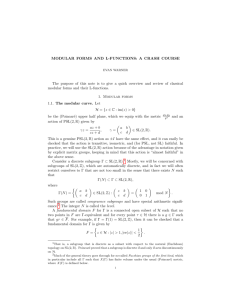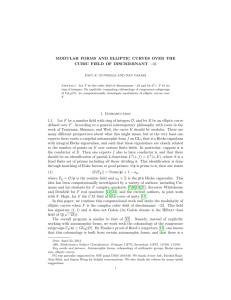Computing modular forms over imaginary quadratic fields
advertisement
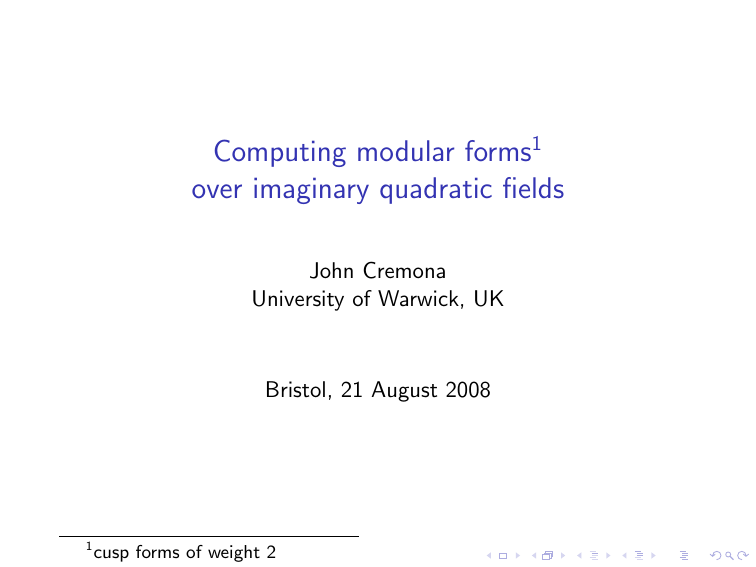
Computing modular forms1
over imaginary quadratic fields
John Cremona
University of Warwick, UK
Bristol, 21 August 2008
1
cusp forms of weight 2
Plan of the talk
I
Goals and motivation
Plan of the talk
I
Goals and motivation
I
History
Plan of the talk
I
Goals and motivation
I
History
I
Cusp forms over imaginary quadratic fields
Plan of the talk
I
Goals and motivation
I
History
I
Cusp forms over imaginary quadratic fields
I
The conjectural correspondence with elliptic curves
Plan of the talk
I
Goals and motivation
I
History
I
Cusp forms over imaginary quadratic fields
I
The conjectural correspondence with elliptic curves
I
The modular symbol method
Plan of the talk
I
Goals and motivation
I
History
I
Cusp forms over imaginary quadratic fields
I
The conjectural correspondence with elliptic curves
I
The modular symbol method
I
Results
Plan of the talk
I
Goals and motivation
I
History
I
Cusp forms over imaginary quadratic fields
I
The conjectural correspondence with elliptic curves
I
The modular symbol method
I
Results
I
References
Goals
I
To develop a better understanding of, and a more explicit
description of, a Shimura-Taniyama-Weil type correspondence
between elliptic curves and modular forms defined over
number fields other than Q;
Goals
I
To develop a better understanding of, and a more explicit
description of, a Shimura-Taniyama-Weil type correspondence
between elliptic curves and modular forms defined over
number fields other than Q;
I
particularly over imaginary quadratic fields.
Motivating questions
Let K be a number field.
1. What do modular forms over K look like?
2. Can they be computed explicitly (say for given weight and
level)?
3. Do they have associated L-series, with functional equations
and interesting arithmetic properties, such as Fourier
coefficients of number-theoretical interest or significant special
values?
4. Do they have associated Galois representations?
5. What does it mean for an elliptic curve defined over K to be
modular?
Motivating questions (contd.)
6. Are all elliptic curves over K modular?
7. Is it possible to construct modular elliptic curves over K
explicitly?
8. If E is a modular elliptic curve over K , can we use the
associated modular form to obtain arithmetic information
about E (K ), in line with the Birch–Swinnerton-Dyer
conjectures?
What is known over number fields
I
Over Q: well understood, with good answer to many of the
questions.
I
Over totally real fields: well-developed theory of Hilbert
Modular Forms; some cases of modularity known.
I
Over general number fields: theory formulated in terms of
adelic functions (or representations), to deal efficiently with
the infinite unit group and (possibly) nontrivial ideal class
group.
Our approach: to specialize the general theory to the case of an
imaginary quadratic field, in order to arrive at as concrete a
description as possible of automorphic forms over these fields,
amenable to explicit computations.
Selected history of the problem
I
1970s and 1980s: Mennicke, Grunewald, Elstrodt
√ and others
carried out some explicit computations over Q( −d) for
d = 1, 2, 3, for split prime levels and weight 2. They produced
tables of newforms and corresponding examples of curves.
I
1970s: Kurčanov extended some of Manin’s results over Q,
including the Manin-Drinfeld Theorem, to imaginary quadratic
fields. The duality between spaces of cusp forms of weight 2
and the homology of quotients of hyperbolic 3-space is clearly
set up, together with the definition of generalized modular
symbols giving explicit generators for the homology.
I
From 1978: I extended the work of Mennicke et al. to all five
Euclidean fields (d = 1, 2, 3, 7, 11) and arbitrary levels, using
more hyperbolic geometry and modular symbols. Tables of
newforms and associated elliptic curves were produced using
programs written in Algol68 (since rewritten in C++).
Selected history of the problem (contd.)
I
Late 1980s: Elise Whitley extended this to the four other
fields of class number 1 (d = 19, 43, 67, 163) and produced
more tables, also using Algol68.
I
Early 1990s: Whitley and I looked more closely at arithmetic
aspects of the newform–curve correspondence, computing and
comparing periods, analytic ranks and other data appearing in
the Birch–Swinnerton-Dyer conjectures.
I
Early 1990s: R. Taylor succeeded in constructing `-adic
Galois representations
associated to automorphic forms over
√
K = Q( −3). Explicit examples, computed with some help
from me, showed that certain elliptic curves defined over K
(and not over Q) were modular in a weak sense.
Selected history of the problem (contd.)
I
Mid 1990s: Jeremy Bygott extends the modular symbol
methods used by me and Whitley to certain fields of higher
class number, specifically
√ class number 2, and produces tables
of newforms over Q( −5), implemented in C++.
I
Early 2000s: Mark Lingham extends the methods to certain
fields of√odd class number,
√ and produces tables of newforms
over Q( −23) and Q( −31) (class number 3), implemented
in Magma.
I
2008: Work starts to unify the above as much as possible, in
order to have working programs maintained for posterity.
Hyperbolic 3-space
I
√
K = Q( −d), R = ZK , DK = disc(K ), wK = #R × ,
(η) = dK (the different of K )
I
H3 = C × R+ = {(z, t) | z ∈ C, t > 0}
I
PSL(2, C) acts on H3 via hyperbolic isometries:
α β
: q 7→ (αq + β)(γq + δ)−1
γ δ
where q = z + tj is a quaternion.
I
The Bianchi group Γ = PSL(2, R) acts discretely on H3 , with
a fundamental region of finite volume bounded by various
geodesic planes, as do congruence subgroups Γ0 (n) for
ideals n of R.
Cusp forms of weight 2 over an imaginary quadratic field
Cusp forms of weight 2 for Γ0 (n):
F = (F0 , F1 , F2 ) : H3 → C3
dt
dz
such that −F0 dz
t + F1 t + F2 t is a Γ0 (n)-invariant harmonic
differential on H3 , well-behaved at the cusps.
F has a Fourier expansion about the cusp ∞; when hK = 1 this
has the form
F (z, t) =
16π 2 wK X
c(a)t 2 K(4π|η|−1 |α|t)ψ(η −1 αz)
|DK |
a
where ψ(z) = exp(2πi(z + z)), K(t) = (− 21 iK1 (t), K0 (t), 12 iK1 (t)),
and a = αR runs over all the integral ideals of R.
The correspondence between newforms and elliptic curves
I
Consider newforms F (z, t) for Γ0 (n) with c(a) ∈ Z.
I
These are eigenforms of a suitable Hecke algebra.
I
Via Mellin transform we obtain an L-series which analytically
continues a Dirichlet series with Euler product, all just as in
the rational case:
Z ∞
wK
|DK |s−1 (2π)−2s Γ(s)2 L(F , s)
Λ(F , s) =
t 2s−2 F1 (0, t)dt =
4
0
where
L(F , s) =
X
c(a)N(a)−s .
a
I
The Dirichlet series L(F , s) thus has an analytic continuation,
and (using a Fricke-type involution) we obtain a functional
equation for Λ(F , s).
The correspondence (contd.)
I
Elliptic curves E defined over K of conductor n have L-series
of the same form
X
L(E , s) =
c(a)N(a)−s
(<(s) > 3/2)
a
I
The adjusted series Λ(E , s), obtained by multiplying by the
same gamma factors as for Λ(F , s), is conjectured to have an
analytic continuation to the whole complex plane and to
satisfy a functional equation.
I
Provided that Λ(E , s) and sufficiently many of its twists do
indeed satisfy functional equations, Weil showed that
L(E , s) = L(F , s) for a suitable modular form F .
I
There are essentially no cases for which these functional
equations are known to hold (only curves which are defined
over Q or their twists).
Eichler-Shimura construction?
I
There is no analogue of the Eichler-Shimura construction to
construct an elliptic curve from a cusp form of weight 2 with
rational Fourier coefficients via periods.
I
The periods of F form a 1-dimensional lattice in R, not a
2-dimensional lattice in C.
I
The generator Ω(F ) of this lattice does seem to be related to
the period lattice of an associated elliptic curve (when there is
one)
I
Ω(F ) does not contain enough information to construct an
elliptic curve.
I
Such a construction (Mennicke’s “pipe dream”) would be very
significant.
I
There are cases in which a newform F has no associated
elliptic curve E defined over K . Any general construction
would need to allow for such exceptions.
Exceptional cases
I
If E has CM by an order in the field K itself, then
L(E , s) = L(F , s) where F is an Eisenstein series.
I
For then hK = 1, E is defined (up to twist) over Q, and the
base-change lift from Q to K of a cusp form f is not a cusp
form in this case, when f has CM in K itself.
Exceptional cases
I
If E has CM by an order in the field K itself, then
L(E , s) = L(F , s) where F is an Eisenstein series.
I
For then hK = 1, E is defined (up to twist) over Q, and the
base-change lift from Q to K of a cusp form f is not a cusp
form in this case, when f has CM in K itself.
I
Some newforms over K with rational coefficients are (up to
twist) the result of base change from Q of classical cusp forms
with “extra twist” which do not have rational coefficents, and
in such cases there may be no corresponding elliptic curve.
A conjecture
Based on general philosophy, the situation over Q, the
computational evidence and the known exceptions, we can
formulate the following:
Open Question: For each newform F for Γ0 (n) with rational
Fourier coefficients, is there either an elliptic curve E defined
over K with conductor n such that L(F , s) = L(E , s), or a
quadratic twist such that F ⊗ is the lift from Q to K of a
modular form f over Q?
Overview of the modular symbol method
I
For each “level” n (an integral ideal of R), the quotient space
X0 (n) = Γ0 (n)\H3 is2 a 3-manifold whose homology may be
computed using modular symbols.
I
When hK = 1, the 1-homology H(n) is dual to the space
S2 (n) of cusp forms of weight 2 for Γ0 (n).
I
The duality respects the Hecke action.
I
Hence, by computing H(n) and the Hecke action on it we can
compute the dimension of S2 (n) and find (via Hecke
eigenvalues) all newforms.
I
When hK > 1 this picture needs some modification.
2
if N(n) is large enough so Γ0 (n) has no nontrivial elements of finite order
Overview of the modular symbol method (Contd.)
I
To compute the homology of X0 (n) we tessellate H3 with
hyperbolic polyhedra.
I
Γ acts on this tessellation: its vertices (cusps), edges, faces
and 3-cells (polyhedra).
I
When hK = 1 the action is transitive on the vertices (the
cusps); in general there are hK orbits.
I
When K is Euclidean the action is transitive on the edges; in
general there are several orbits. Each orbit leads to a “type”
of modular symbol.
I
In general there are several orbits on the faces; each orbit
leads to a type of relation between the modular symbols.
I
In general there are several orbits on the polyhedra.
Overview of the modular symbol method (Contd.)
For each field we do a precomputation to find the tessellation and
the Γ-orbits on the vertices, edges and faces.
√
I Example: K = Q( −1): the tessellation is of of octahedra,
the Γ-orbit of the one with vertices at 0, 1, i, 1 + i, (1 + i)/2
and ∞, which consists of 12 copies of the fundamental region
for Γ glued together.
Overview of the modular symbol method (Contd.)
For each field we do a precomputation to find the tessellation and
the Γ-orbits on the vertices, edges and faces.
√
I Example: K = Q( −1): the tessellation is of of octahedra,
the Γ-orbit of the one with vertices at 0, 1, i, 1 + i, (1 + i)/2
and ∞, which consists of 12 copies of the fundamental region
for Γ glued together.
√
I Example: K = Q( −163): the tessellation has 25 Γ-orbits of
3-cells (11 tetrahedra, 8 triangular prisms, 3 square pyramids,
2 hexagonal caps and 1 cuboctahedron).
Overview of the modular symbol method (Contd.)
For each field we do a precomputation to find the tessellation and
the Γ-orbits on the vertices, edges and faces.
√
I Example: K = Q( −1): the tessellation is of of octahedra,
the Γ-orbit of the one with vertices at 0, 1, i, 1 + i, (1 + i)/2
and ∞, which consists of 12 copies of the fundamental region
for Γ glued together.
√
I Example: K = Q( −163): the tessellation has 25 Γ-orbits of
3-cells (11 tetrahedra, 8 triangular prisms, 3 square pyramids,
2 hexagonal caps and 1 cuboctahedron).
I
Modular symbols for this field are therefore rather
complicated!
Summary of results I. Class number 1 fields
√
K = Q( −d) for d ∈ {1, 2, 3, 7, 11}: in my thesis (1981) I
computed S2 (n) for levels n with norms N(n) up to some bound;
this was continued by Elise Whitley (1990) for
d ∈ {19, 43, 67, 163}.
d
Bound on N(n)
Number of newforms F
1
2
3
7 11 19 43 67 163
500 300 500 300 200 500 230 265 100
39 36 27 17 17 55
7
6
0
These progams were all in Algol 68. For the Euclidean fields I
rewrote the program in C++: rerunning the above (d ≤ 11) now
takes under 5s on my laptop (demonstrations on request).
Higher class number: hK > 1
I
When kK > 1, the adelic theory tells us that we should
replace H3 by hK disjoint copies; while Γ acts on the first,
twisted forms of Γ act on the others.
I
The homology of the quotient is in duality not with S2 (n) but
with ⊕χ S2 (n, χ) where the sum is over all unramified Dirichlet
characters χ.
I
In the Hecke action, each operator Tp permutes the
components according to the class of p: the Hecke algebra is
graded by the class group.
I
In practice we can obtain all information from the action of
just the principal Hecke operators Ta (with a principal),
acting on the principal component.
I
Hence we still only need to compute the homology of X0 (n).
hK = 2
The case hK = 2 was treated in Jeremy
√ Bygott’s thesis (1998),
with examples computed for K = Q( −5).
I
The homology of X0 (n) is only “half” the space we need.
I
We only compute “half” the Hecke operators (the principal
ones).
I
Each system of eigenvalues for these extends in two ways to
eigenvalue systems for the full Hecke algebra: these differ only
in the signs of the eigenvalues of Tp for non-principal p.
I
Thus each eigenspace in H 1 (X0 (n)) corresponds to two
eigenforms which are quadratic twists of each other by the
unramified quadratic character of K .
√
Results for Q( −5)
√
Bygott’s thesis contains a table of all newforms for Q( −5) of
level n with N(n) ≤ 135.
For each, he gives the Hecke eigenvalues for small primes p.
Bygott’s program is in C++ and is based on mine for the class
number one fields, with extra code to handle ideals etc..
Demonstrations on request.
Odd vs. even class number
Bygott’s thesis showed that the case of class number 2 could be
handled nicely by using a larger group, containing Γ with index 2,
to pick out the classes with trivial character directly. This case
then becomes (as far as the hyperbolic geometry is concerned)
rather like the case hK = 1.
Odd vs. even class number
Bygott’s thesis showed that the case of class number 2 could be
handled nicely by using a larger group, containing Γ with index 2,
to pick out the classes with trivial character directly. This case
then becomes (as far as the hyperbolic geometry is concerned)
rather like the case hK = 1.
The same ideas work whenever C`K has exponent 2.
Odd vs. even class number
Bygott’s thesis showed that the case of class number 2 could be
handled nicely by using a larger group, containing Γ with index 2,
to pick out the classes with trivial character directly. This case
then becomes (as far as the hyperbolic geometry is concerned)
rather like the case hK = 1.
The same ideas work whenever C`K has exponent 2.
Lingham’s thesis showed that a different simplification is possible
for odd class number. In this case, the full eigenvalue system may
be computed from the eigenvalues for principal Hecke operators
together with knowledge of the central character (which for
example may be taken to be trivial).
Odd vs. even class number
Bygott’s thesis showed that the case of class number 2 could be
handled nicely by using a larger group, containing Γ with index 2,
to pick out the classes with trivial character directly. This case
then becomes (as far as the hyperbolic geometry is concerned)
rather like the case hK = 1.
The same ideas work whenever C`K has exponent 2.
Lingham’s thesis showed that a different simplification is possible
for odd class number. In this case, the full eigenvalue system may
be computed from the eigenvalues for principal Hecke operators
together with knowledge of the central character (which for
example may be taken to be trivial).
Ongoing work will show how to handle arbitrary class groups, in
every case obtaining full eigenvalue systems just from the action of
principal Hecke operators on the “principal” homology of X0 (n).
hK = 3
The case hK = 3 was treated in Mark√Lingham’s thesis (2005),
√
with examples computed for K = Q( −23) and K = Q( −31).
He computed all levels of norm up to 200 in each case, finding
many newforms with eigenvalues in fields of degree up to 3.
For many of the newforms with rational eigenvalues Lingham also
found corresponding3 elliptic curves.
Lingham also showed how to compute Atkin-Lehner and Fricke
involutions, and degeneracy maps, even in the case where the
ideals involved are not principal. His results apply to all odd class
numbers, and ongoing work will extend them to the general case.
3
in the sense that the conductor equals the level and the first several Euler
factors of the L-series agree.
References (theses)
Theses (see my web page
http://www.warwick.ac.uk/staff/J.E.Cremona/):
I
J. E. Cremona (Oxford 1981), “Modular symbols”.
I
E. Whitley (Exeter 1990), ”Modular forms and elliptic curves
over imaginary quadratic number fields of class number one”.
I
J. S. Bygott (Exeter 1998), ”Modular forms and elliptic
curves over imaginary quadratic number fields”.
I
M. P. Lingham (Nottingham 2005), ”Modular forms and
elliptic curves over imaginary quadratic fields”.
References (papers)
Papers:
I
JEC, “Hyperbolic tessellations, modular symbols, and elliptic
curves over complex quadratic fields”, Compositio
Mathematica 51 (1984), 275–323.
I
JEC and E. Whitley, “Periods of cusp forms and elliptic curves
over imaginary quadratic fields”, Math. Comp. 62 (1994),
407–429.
I
JEC, “Modular forms and Hecke operators over number
fields”, pre-preprint 2007.


